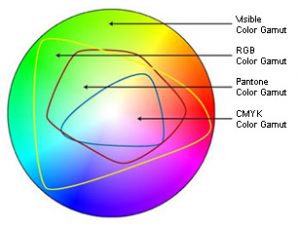Twitter uses a specific blue – not the same as Facebook blue, or Ford blue, or “Big Blue” IBM. Coke always wants the same red, whether its on a T-shirt, paper, plastic, a television screen or a glass bottle. To reproduce color consistently, especially across different media, platforms, techonologies and visual arenas, everyone needs to be communicating in the same language of color, so to speak. The PANTONE® Matching System is that language – an industry standard and means of selecting, communicating, reproducing, matching and controlling colors. For offset, lithographic printing, Pantone created a Color Formula Guide with well over 1000 classified colors that fill the CMYK gamut. From a set of basic inks, each of these colors can be mixed.
For spot color printing, the Pantone Guide contains ink mixing instrusctions for each color, a “recipe” with amounts given both in parts and percentages. If a printer needs a large quantity of ink, or is doing regular printing for clients who use a specific color for their brand, these inks will be purchased premixed. But for smaller quantities, each color in the Pantone Guide can be created with a mixture of 2 or more of 14 standard base colors. They are: Yellow, Yellow 012, Orange 021, Warm Red, Red 032, Rubine Red, Rhodamine Red, Purple, Violet, Blue 072, Reflex Blue, Process Blue, Green, and Black.
In the image above, our printer is mixing PMS 151 Orange for a client’s job. The formula for that exact color is 12 parts of PANTONE Yellow (or 75%) and 4 parts of PATNONE Warm Red (or 25%). For this small amount of ink needed, he weighs each ink amount on a scale and then mixes thoroughly together for the correct color match, which is then tested alongside the PANTONE preprinted swatch for that color to doublecheck the outcome.
Pantone recently unveiled their cloud system of color management, PANTONELive: “a cloud-based color bank.” It is a color management system for companies and brand owners who do marketing over a large variety of media and across a diverse geographical area to ensure everyone is speaking that same color language.


















